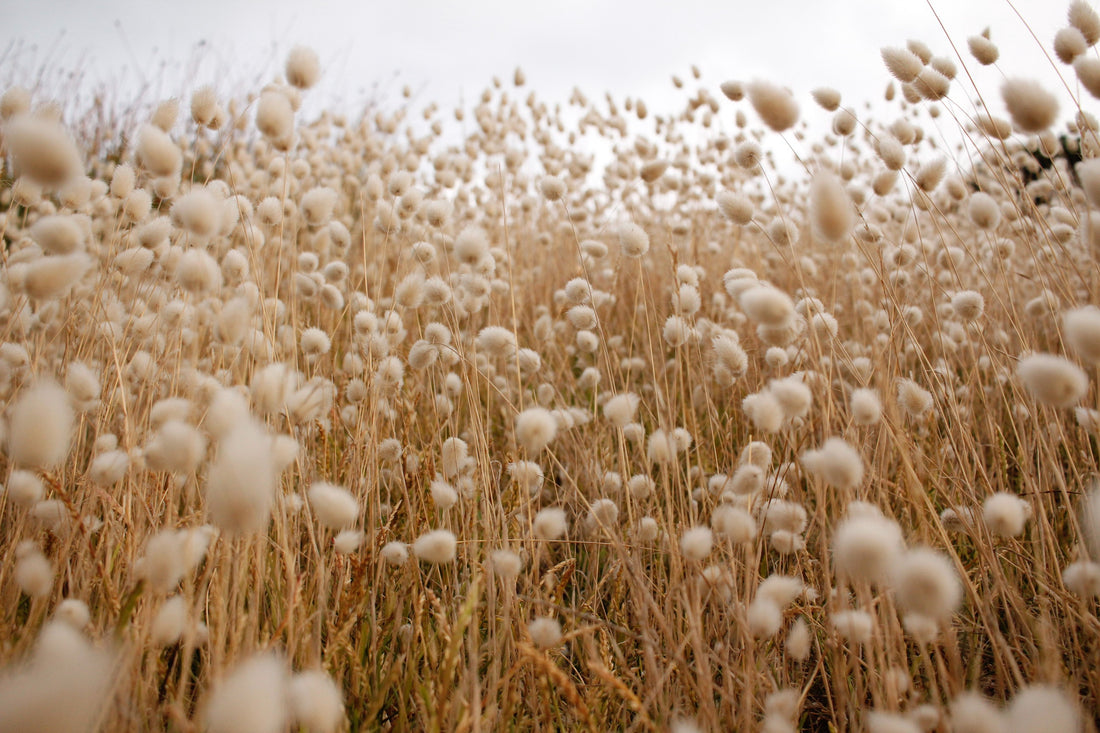
Organic Cotton: The Eco-Friendly Solution for Water Conservation
Share
As we continue to grapple with the consequences of climate change and environmental degradation, the need for sustainable practices has never been more critical.
The textile industry has a significant environmental impact, especially in water usage and pollution.
Cultivating conventional cotton is extremely water intensive and typically involves the use of harmful pesticides. Organic cotton, however, offers a more sustainable alternative.
Through practices such as crop rotation and using rain-fed water sources, organic cotton can drastically reduce water usage and offer a more environmentally friendly choice.
What is Organic Cotton? Understanding the Sustainable Fabric Choice
A staggering 66% of consumers are now more inclined towards brands that are environmentally responsible. That number jumps up to 75% when looking at Millennials. The curiosity isn't just around the term "organic" but the integrity behind it.
In a market brimming with labels and claims, it's important to be able to distinguish genuine organic cotton from the facades.
Organic cotton is a natural, renewable, and biodegradable fiber that holds significant potential for reducing environmental harm and conserving water resources.
You may be wondering, how does organic cotton differ from conventional cotton?
Organic cotton is grown using methods and materials that have a low environmental impact. It is produced without the use of toxic and persistent pesticides and synthetic fertilizers, and it is typically grown on land that has been treated and prepared according to the guidelines of organic agriculture.
Unlike conventional cotton, organic cotton production maintains soil fertility through crop rotation and uses biological pest control methods instead of harmful chemicals. This not only makes the cultivation process more eco-friendly but also preserves water quality by reducing runoff that can contaminate water supplies.
A crucial aspect of organic cotton farming is that it predominantly relies on rain-fed sources, thus minimizing the use of irrigated water. This practice contributes to significant water conservation, which is an increasingly important consideration in our era of climate change and dwindling water resources.
From an industry perspective, organic cotton is a burgeoning market. The Global Organic Textile Standard (GOTS) and other organizations certify organic cotton products, ensuring that they adhere to stringent environmental and social criteria throughout their production.
By choosing organic cotton products, consumers can play an active role in promoting sustainable farming practices that not only conserve water but also create safer working conditions for cotton farmers and a healthier planet for us all.
How Much Water Does Conventional Cotton Consume?
According to The World Counts, it takes 10,000 liters of water to produce a kilogram of cotton. That translates to roughly 2700 liters of water per cotton T-Shirt.
This vast water footprint is due to the irrigation-heavy methods used in conventional cotton farming. Furthermore, non-organic cotton is often grown in regions where water scarcity is already a significant issue, exacerbating the problem.
Additionally, conventional cotton cultivation relies heavily on synthetic fertilizers and pesticides, which can contaminate local water sources when they run-off into them. These chemicals can harm aquatic life and render water undrinkable for local communities.
How Organic Cotton Saves Water: An In-Depth Look
The growing realization of the unsustainable water consumption associated with conventional cotton has spurred increased interest in organic cotton as a more eco-friendly alternative. Let's delve into the specific ways in which organic cotton production helps conserve this vital resource:
1. Adoption of Water-Efficient Farming Techniques
Organic cotton production embraces various agricultural techniques that are not only eco-friendly but also water-efficient.
One of these techniques is crop rotation, which involves alternating the type of crop grown in each field over time. This practice breaks the cycle of pests and diseases, reducing the need for chemical treatments and enhancing soil fertility. Improved soil health is directly linked to better water retention, meaning that fields require less irrigation, thus saving water.
2. Rain-Fed Water Sourcing
A significant characteristic of organic cotton farming is its reliance on rain-fed water, a practice which drastically reduces the need for artificial irrigation.
Conventional cotton farming, on the other hand, relies heavily on irrigation, accounting for approximately 3% of the global water use for agriculture.
By utilizing rain-fed methods, organic cotton farmers save significant volumes of water and also alleviate pressure on water-stressed regions.
3. No Synthetic Pesticides or Fertilizers
Organic farming rules out the use of synthetic pesticides and fertilizers, which not only require water for their application but also lead to water pollution from runoff.
Organic cotton farmers use organic compost and biological pest control, which are much less harmful to the water system. By eliminating these chemicals, organic cotton farming decreases the contamination of local water sources, ensuring that the water remains clean and safe for local communities and ecosystems.
4. Use of Drought-Resistant Cotton Varieties
Organic cotton farmers often opt for cotton varieties that are adapted to local conditions and are more resistant to drought. These native varieties can thrive with lower water requirements, thus further reducing the water footprint of organic cotton.
To sum up, organic cotton farming incorporates a multitude of practices that contribute to significant water conservation. By focusing on improving soil health, optimizing the use of rainwater, eliminating the need for synthetic chemicals, and choosing drought-resistant varieties, organic cotton farming sets a high standard for sustainable water use in agriculture.
Breaking Down Organic Cotton ROI: A Comprehensive Model
Decoding the ROI of organic cotton might appear intricate, but with a structured approach, it becomes clear. When we discuss ROI here, we're not merely talking about financial returns. We're delving deeper, evaluating the environmental, social, and long-term economic returns.
Here's an example to illustrate the ROI of Organic Cotton:
Suppose a fashion brand, EcoVogue, decides to source materials for its upcoming collection. Here's a basic comparison:
Conventional Cotton Production Costs:
- Fertilizers and Pesticides: $5,000
- Water usage due to inefficient irrigation: $4,000
- Health treatments for farmers exposed to chemicals: $2,000
- Environmental cleanup costs: $3,000 Total Cost (for Conventional): $14,000
Organic Cotton Production Costs:
- Natural compost and manure: $3,000
- Efficient water management systems: $2,500
- Fair wages and enhanced living standards for farmers: $3,500
- No environmental cleanup costs Total Cost (for Organic): $9,000
Returns Considered:
- Brand reputation enhancement
- Reduced water usage
- Soil health improvement
- Positive social impact on farming communities
Calculating the ROI: ROI = (Total Returns – Total Cost) / Total Cost
Using the above data and factoring in the qualitative benefits like enhanced brand image, lesser ecological impact, and positive community upliftment, the ROI on organic cotton is not just evident in savings but also in its alignment with sustainable practices.
Further Considerations: When assessing the real cost, it's paramount to factor in the long-term benefits. While organic cotton might sometimes seem pricier upfront, the collateral damage (both ecological and social) of conventional cotton is far higher. Comparing the benefits in terms of brand loyalty, customer trust, and a reduced carbon footprint makes the ROI of organic cotton overwhelmingly positive.
Precision Matters: Identifying What Metrics Truly Count
Understanding the ROI of organic cotton goes beyond surface-level numbers. It demands a dive into the metrics that genuinely resonate with a brand's sustainability goals and the global call for eco-responsibility.
Tangible vs Intuitive Metrics: What's Your Focus?
Tangible metrics are direct, quantifiable measurements. These could range from the reduced gallons of water used, acres of soil preserved, to the decrease in chemical runoffs.
In contrast, intuitive metrics are more abstract but crucial. They encompass elements like the brand's reputation, customer loyalty due to sustainable practices, or the sense of community among organic cotton farmers.
While tangible metrics offer a clear view of immediate returns, intuitive metrics paint the broader picture, connecting the brand to a grander narrative of planetary health and ethical choices. For instance, a survey by EcoStats revealed that 80% of customers felt a deeper brand connection when they knew products were made from organic cotton.
In the journey of sustainability, it's not an either-or choice. Both tangible and intuitive metrics are instrumental in shaping the narrative and determining the depth of impact.
Getting Started with Organic Cotton: A Pragmatic Guide
So, you're convinced about the benefits of organic cotton, and its ROI appeals to your brand's sustainable mission. How do you embark on this transformative journey? Whether you're a budding eco-entrepreneur or an established brand eager to pivot, here's a roadmap to seamlessly weave organic cotton into your fabric supply chain.
1. Research and Partner with Credible Suppliers
To ensure the authenticity of your organic cotton, engage with suppliers certified by international standards like the Global Organic Textile Standard (GOTS) or Organic Content Standards (OCS). Prioritize those with transparent supply chains and ethical farming practices.
2. Educate Your Team
Your team should be well-versed in the benefits of organic cotton, from its environmental advantages to the positive social implications. Organize workshops or training sessions. When everyone is onboard and informed, the transition becomes smoother.
3. Adapt Your Marketing Message
Embrace storytelling. Share the journey of your organic cotton - from the farm, through processing, to the finished product on your shelves. Such narratives resonate with eco-conscious consumers and emphasize your brand's commitment to a sustainable future.
4. Commit to Continuous Improvement
Iterative feedback loops are crucial. Regularly assess your supply chain's impact, gather feedback from stakeholders, and remain open to adopting more sustainable practices. Sustainability isn't a destination but an ongoing journey.
5. Engage with the Community
Connect with organic cotton farming communities. Understand their challenges, celebrate their successes, and work together to fortify the organic cotton ecosystem. This mutual relationship ensures a sustainable supply and enriches your brand's narrative.
The Real-World Impact of Organic Cotton
The potential for water-saving with organic cotton is significant. For instance, the Textile Exchange’s Organic Cotton Farm & Fiber Report 2020 found that organic cotton farming can reduce water consumption by up to 91% compared to conventional methods.
In a world where over two billion people live in countries experiencing high water stress, the shift to organic cotton could be a crucial step in global water conservation efforts. Not only does organic cotton save water, but it also helps maintain healthy ecosystems, supports better conditions for cotton farmers, and results in a safer product for consumers.
While organic cotton currently makes up a small percentage of the global cotton market, there's a growing demand for more sustainable textiles. As consumers and businesses become more aware of the environmental impacts associated with conventional cotton production, it is hoped that the move toward organic and other sustainable fibers will accelerate.
